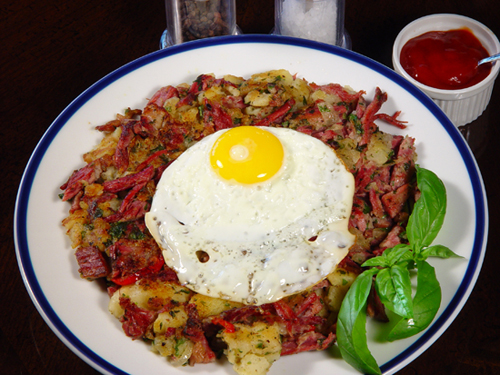Corned Beef Hash

- 1 1/2 pounds (about 4 medium) russet (Idaho) potatoes
- 2 medium onions (8 to 10 ounces total)
- 1 red bell pepper
- 2 tablespoons vegetable or olive oil
- 1/2 teaspoon kosher salt, plus additional to taste
- 1 pound cooked corned beef (see instructions)
- 1/3 cup finely chopped flat-leaf parsley
- Freshly ground black pepper to taste
- Warmed ketchup (optional)
- Poached eggs (optional)
Wash but do not peel the potatoes.
Cook the potatoes until tender when pierced with a thin-bladed knife, either in a preheated 375-degree oven for about 1 hour or in the microwave on high power. Set aside to cool. When cool enough to handle, cut the potato in half lengthwise and use a big spoon to scoop out the flesh, in odd-size chunks. Discard the peels; place the potato chunks in a large bowl.
While the potatoes are cooking, cut the onions and bell pepper into slices about 1/4 inch wide.
Heat 1 tablespoon of the oil over medium heat in a 10-inch skillet, preferably nonstick. When the oil is hot, add the onions, bell pepper and about 1/2 teaspoon salt and toss to combine. Reduce the heat to medium-low and cook, stirring occasionally, until the onions are fairly tender, 12 to 15 minutes. Transfer to the bowl with the potatoes; set aside to cool for a few minutes. Do not wash the skillet; you will need it to cook the hash.
If you are making your hash from leftover meat, cut it into strips about 1/2 inch wide. But the very best hash with the very best texture is made with shredded beef, so if you cook your own or buy it in a piece rather than sliced, cut it across the grain into slices about 1 inch wide, then use your fingers to pull the beef apart into shreds. (This is easier if the meat is not too cold.)
Add the corned beef and the parsley to the potato mixture along with some salt and lots of freshly ground black pepper. Use your hands to combine the ingredients, squeezing to mash some of the potatoes; there should be a variety of potato textures, ranging from a puree (which will help hold the hash together) to chunks of different sizes. Taste and adjust the seasoning accordingly.
Return the skillet to medium-low heat and warm the remaining 1 tablespoon oil. When the oil is hot, scoop the hash mixture into the skillet and, using the back of a wooden spoon or a spatula, tamp down the mixture to compact it and even the top. Cook for at least 20 minutes, until nice and brown.
Now, you must turn it. Wearing oven mitts, first take a rubber or flexible metal spatula and slide it between the hash and the skillet to make sure that none of the hash is sticking to the pan. Place a plate or an upside-down pan lid next to the edge of the skillet and, working quickly and deftly, slide the hash out of the skillet and onto the flat surface in a single movement. Invert the skillet over the hash and flip the hash over. The crusty side should now be on top. Return the skillet to medium-low heat and cook until crisp and brown on the second side, about 20 minutes.
Slide the hash onto a serving platter. (An alternative approach is, after the first 20 minutes of browning, to break up the hash and mix the crusty parts with the non-crusty parts, then to repeat this after 10 minutes, finally leaving it undisturbed until the bottom crust is brown again. This results in extra crispness with the bonus of not having to flip the hash.)
To serve, cut the hash into wedges. Note that the wedges will not necessarily hold together like perfect slices of cake. If you like, serve with warmed ketchup and top with one or two softly poached eggs per person.
- Home
- Recipes
- Hors d'Oeuvres
- Salads
- Vegetables & Sides
- Sauces, Dressings, Dips and Rubs
- Breakfast
- Pasta and Rice
- Soups
- Mains
- Oven Barbeque Brisket
- Chicken Marsala
- Mom's Fried Chicken Wings
- Moules Mariniere
- Steak Tartare
- Corned Beef and Cabbage
- Beef Stew
- Choucroute Garni
- Grilled Shrimp andScallops
- Roasted Chicken
- Braised Short Ribs
- Durbin Dogs
- Singapore Chili Shrimp
- Chicken Fried Steak
- Grilled Sword Fish
- Lamb Shish Kabob
- Pizza
- Diana's Authentic Spanish Paella
- Coq au Vin
- Desserts
To make roast beef hash, follow the corned beef hash recipe, using the shredded, well-done meat from around and between the bones of a rib roast, supplemented by trimmings from the deckle: the thin layer of meat that lies on top of the rib roast, which also tends to get well done even if you take care to roast your beef to medium-rare. Add 1/4 teaspoon crushed red pepper flakes or 1/2 teaspoon Hungarian paprika to the onions and peppers as they cook, and supplement the parsley with 1 teaspoon fresh thyme leaves.